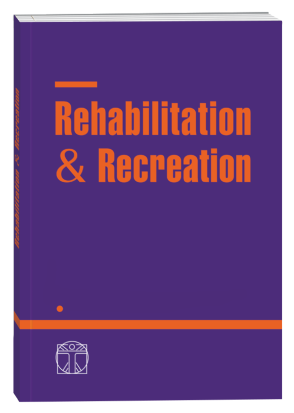THE EFFICIENCY OF PHYSICAL REHABILITATION IN PATIENTS WITH RHEUMATOID ARTHRITIS
DOI:
https://doi.org/10.32782/2522-1795.2023.17.8Keywords:
rehabilitation, connective tissue disease, inflammatory activity index, pain scale, muscle strength.Abstract
Purpose is to assess the effectiveness of physical rehabilitation measures in patients with rheumatoid arthritis. Material. To identify the impact of physical rehabilitation measures on the course of the disease in patients with rheumatoid arthritis (RA), 37 men aged 48.5 ± 9.6 years were examined. For the comparison of anthropometric parameters, a group of healthy men of the appropriate age (n = 20) was additionally examined. Comparison group (CG) (n = 18) – patients who recovered in the post-hospital period on their own, according to general recommendations. The main group (MG) (n = 19) – patients who during the same period (1.5 months) underwent a physical therapy program (classes with dosed physical activity using isometric loads, as well as breathing exercises; exercises to increase the strength of muscles, for correct distribution of muscle tone and restoration of joint mobility). The condition of the patients was assessed based on the results of the activity of rheumatoid arthritis according to the CDAI index, according to the assessment of the degree of pain using the visual analog pain scale (VAS), according to anthropometric parameters: weight, height, body mass index (BMI), hand muscle strength (right and left hands) and strength indices (SI). The results. During the initial examination, the difference between the anthropometric indicators of patients with rheumatoid arthritis and healthy men was revealed. Patients with RA had significantly lower indicators of hand strength of both the right and left hand (p < 0.05). Indicators of strength indices were even lower (p < 0.01), because patients with RA had a tendency to decrease body weight (p > 0.05). Patients of the MG and the CG at the initial examination did not differ from each other in all studied parameters (p > 0.05). During the re-examination, the patients of the main group showed statistically significantly better results (p < 0.05) compared to the initial indicators according to the following parameters: according to the CDAI index – by 39.5%, according to the VASH scale – by 48.2%. They also showed a tendency to increase hand strength of both hands and strength indices (p > 0.05). At the time when the patients of the comparison group, who recovered on their own, only a tendency to improve all the studied parameters was observed (p > 0.05). Conclusions. The obtained results give grounds for asserting that dosed, individually selected motor activity has a positive effect on the course of the disease in patients with RA. In them, the activity of the inflammatory process decreased, the level of pain decreased, and there was also a tendency to improve the condition of the motor apparatus.
References
Гонт А.А., Зарудна О.І. Ревматоїдний артрит – історія, сучасні погляди, тактика, результат. Медсестринство. 2020. № 4. С. 30–36. DOI: https://doi.org/І0.11603/2411-1597.2020.4.11870.
Коваленко В.М., Шуба Н.М., Борткевич О.П., Гарміш О.О. Проєкт уніфікованого клінічного протоколу медичної допомоги пацієнтам із ревматоїдним артритом. Український ревматологічний журнал. 2013. № 1(51). С. 5–11.
Коритко З.І, Медико-біологічні основи рухової активності: навчальний посібник. Львів: ЛДУФК ім. Івана Боберського, 2020.
с. URL: http://repository.ldufk.edu.ua/handle/34606048/27946.
Коритко З.І., Поник Р.М., Купріненко О.В. Вплив засобів фізичної реабілітації на якість життя хворих при ревматоїдному артриті. Клінічна та експериментальна біохімія та фізіологія. 2020. № 4 (88). С. 45–52. URL: https://doi.org/10.25040/ecpb2019.04.045.
Ногас А.М. Ефективність впливу реабілітаційних заходів на відновлення функції верхніх кінцівок у хворих на ревматоїдний артрит. Public health journal. 2023. № 3. С. 88–94. DOI: https://doi.org/10.32782/pub.health.2023.3.11.
Ногас А.М. Ревматоїдний артрит – сучасний стан проблеми. Фізичне виховання, спорт і культура здоров’я у сучасному суспільстві. 2013. № 1 (21). С. 298–301.
Поник Р.М., Коритко З.І. Захворюваність та особливості реабілітації хворих на ревматоїдний артрит в умовах сьогодення. Здобутки клінічної та експериментальної медицини. 2019. № 3. С. 183–187. DOI: https://doi.org/10.11603/1811-2471.2019.v.i3.10504.
Baker JoF, Mostoufi-Moab S, Long Ji, Taratuta E, Leonard MB, Zemel B. (2019) Association of Low Muscle Density With Deteriorations in Muscle Strength and Physical Functioning in Rheumatoid Arthritis. Arthritis care & research, 73(3): 355-363. https://doi.org/10.1002/acr.24126.
Bemer С, Erlacher L, Quittan M, Fenzl KH & Domer TE. Workability and Muscle Strength in Patients with Seropositive Rheumatoid Arthritis: Survey Study Protocol. JMIR research protocols. 2017; 6(3):e36. https://doi.org/10.2196/resprot.6449.
Bennett JL, Pratt AG, Dodds R et al. Rheumatoid sarcopenia: loss of skeletal muscle strength and mass in rheumatoid arthritis. Nat Rev Rheumatol, 2023; 19:239–251. https://doi.org/10.1038/s41584-023-00921-9.
Boonstra A.M., Schiphorst Preuper H.R., Reneman M., Posthumus J.B., Stewart R.E. Reliability and validity of the visual analogue scale for disability in patients with chronic musculoskeletal pain. Int J Rehabil Res. 2008. № 31. С. 165–169.
Farrow M., Biglands J., Tanner S., Henson E.M.A., Buch M.H., Emery P., Tan A.L. Muscle deterioration due to rheumatoid arthritis: assessment by quantitative MRI and strength testing. Rheumatology (Oxford, England). 2021. № 60 (3). Р. 1216–1225. DOI: https://doi.org/10.1093/rheumatology/keaa364.
Korytko Z., Kulitka E., Bas O., Chomenka H., Zahidnyy V. & Yakubovskyi T. Adequacy criteria of physical loadings and their use in sports, physical education, and physical rehabilitation. Physical Education, Sport and Health Culture in Modern Society. 2020. № 2(501). С. 68–77. DOI: https://doi.org/10.29038/2220-7481-2020-02-68-77.
Zsofia N., Szigedi E., Takacs S., Csaszar-Nagy N. The Effectiveness of Psychological Interventions for Rheumatoid Arthritis (RA): A Systematic Review and Meta-Analysis. Life. 2023. № 13 (3). Р. 849. DOI: https://doi.org/10.3390/life13030849.
Smith M.H., Berman J.R. What Is Rheumatoid Arthritis? JAMA. 2022. № 327 (12). Р. 1194. DOI: https://doi.org/10.1001/jama.2022.0786.
Steinz M.M., Santos-Alves E., Lanner J.T. Skeletal muscle redox signaling in rheumatoid arthritis. Clin Sci (Lond). 2020. № 134 (21). Р. 2835–2850. DOI: https://doi.org/10.1042/CS20190728.
Sul B., Lee K.B., Joo Y.B., Hong B.Y., Kim J.-S., Kim K.-J., Park K.-S., Park Y.-J., Lim S.H. Twelve Weeks of Strengthening Exercise for Patients with Rheumatoid Arthritis: A Prospective Intervention Study. J. Clin. Med. 2020. № 9. Р. 27–92. DOI: https://doi.org/10.3390/jcm9092792.
Downloads
Published
How to Cite
Issue
Section
License

This work is licensed under a Creative Commons Attribution-NonCommercial-NoDerivatives 4.0 International License.











